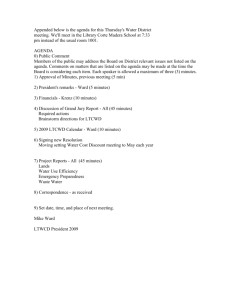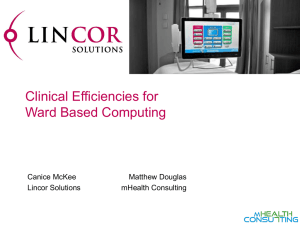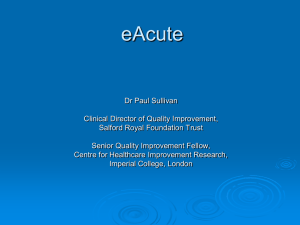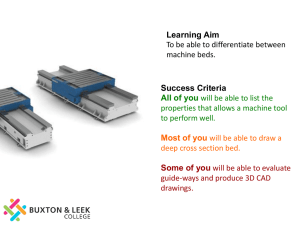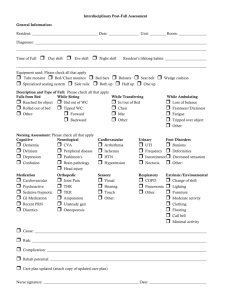Implementation of the Four Hour Program at
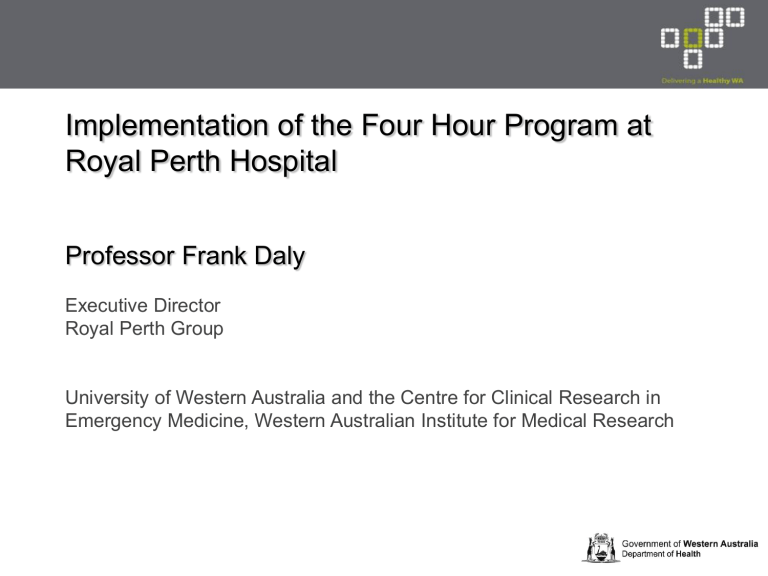
Implementation of the Four Hour Program at
Royal Perth Hospital
Professor Frank Daly
Executive Director
Royal Perth Group
University of Western Australia and the Centre for Clinical Research in
Emergency Medicine, Western Australian Institute for Medical Research
Emergency Physician and Clinical Toxicologist
Head of Emergency Medicine RPH 2005-2008
Clinical Chair of State Emergency Taskforce 2008
Royal Perth Hospital Director of Clinical Reform and Improvement
2008-2011
Executive Clinical Lead State Four Hour Program (WA Health System
Improvement Unit) 2009-2011
Acknowledgements
Kate Brockman
– Royal Perth Hospital Facility Lead 2008-2011
Dr Hannah Seymour
– Consultant Geriatrician
– Clinical Lead Four Hour Program RPH 2011
Doris Lombardi
– Director Operations RPH
Kate Fatovich
– Project Officer Royal Perth Hospital 2011-2012
Royal Perth Group
Royal Perth Hospital
– 583 beds
– ED 80,000 presentations each year
– State Adult Major Trauma Centre
– Admission rate 45%
Shenton Park Campus
– 190 beds
– State rehabilitation services
– Elective orthopaedics
Bentley Health Service
– 224 beds
– Tertiary mental health services
– Aged care and rehabilitation
– Community surgical and obstetric services
Baseline state mid-2008
Average 166 presentations a day
– Overall 40% (66 of 166) of presentations admitted or discharged within
4 hours
– 42% admission rate
– 52% of discharged within 4 hours
– 23% (16 of 70 admissions) per day admitted within 4 hours
– 50% of admissions (35 patients per day) stayed in the ED > 8 hours
Opinions
Access block has many contributing root causes across the whole hospital (and beyond). There is a wide literature describing the adverse effects of access block on patient outcomes
Simultaneous challenge of increased demands on relatively fixed resources
Attempts to improve access block by incremental change or generic solutions are seldom successful or sustainable
A detailed diagnostic process is required to achieve a detailed quantitative understanding of the root causes of access block for your patients in your hospital
Any lessons from the United Kingdom Four Hour Rule relevant to Western Australia pertained only to strategy and not solutions
The strategy we learned from the UK and attempted emulate:
• Strong consistent political and executive commitment, good governance and performance management
• An urgent stretch target to drive innovation across the whole system
• A collaborative patient-focused data-driven methodology to create solutions based on the identified root causes
We decided that the change around the Four Hour Program needed a strong set of agreed values shared by staff and patients (the why )
In our case…
– Quality patient care is effective, safe, personal and timely
– Every patient counts, and to them, every minute counts
– The most important resource in health is its workforce
Delivering access to inpatient services within four hours requires
– Re-engineering of processes across the whole hospital
– A much greater use of business intelligence
– Clear accountability and performance management
– Attention to detail
A large scale change initiative
We established a state-wide governance structure
– Standard teams
– Regular structured reporting
– Data dashboards
Hospital teams followed a standard redesign methodology
Many root causes highlighted problems with governance and organisational cultures
– Roles and responsibilities
– Accountability for change and performance
Western Australian Redesign Methodology
Standardised; uses principles from
6 Sigma, Lean, project and change management
Suited to large organisations and systems
Centred on the patient’s care and experience
Incorporates the voice of the patient and staff
Led by clinicians; decisions based on data
Follows a ‘DMAIC’ process
State Four Hour Governance
The Three Year WA Four Hour Program
Understand problems at patient level
First 6 months
• D efine problem
• M easure impact
• A nalyse root causes
• I mprove process by developing solutions
Implement new processes derived locally
Next 18 months
Enter C ontrol by…
Implementing solutions
Revisiting DMAI
Measuring impact
Maintain new processes
24 months/ongoing
•Reach 85% target
•Maintain solutions and target of
90%
Resourcing
Funded by the COAG National Partnership Agreement on Hospital and Health Workforce reform ($76M)
Each of the 17 hospitals had
– Clinical lead 0.2 FTE (3 years)
– Facility program lead (3 years)
– Seconded central program advisor (First 6 months)
– Seconded central program data analyst (First 6 months)
Sites submit business cases for non-recurrent spending to resource solutions derived from the redesign methodology
Recurrent expenditure sourced from Area Health Service budgets
Spending at Royal Perth Hospital
General Surgery Ward Renovation - $1.7M
Renovation to Operations Centre in ED - $70K
Ward computers - $15K
Recurrent funding ED
– 1 FTE consultant
– 1 FTE Registrar
– 3.5 FTE Nursing
– 5 FTE Patient Support and Clerical
Recurrent funding Acute (medical) Assessment Unit
– 1.5 FTE consultant
– 1 FTE Registrar
– 2 FTE Clerical
Four Hour Statewide Dashboard
Dashboard indicators by group
Activity and Utilisation Measure
ED Attendances
Admissions from ED (Total)
Admissions from the ED (Mental Health)
% of ED attendances transferred to another hospital
System Integration and Change Measures
% ED attendances with LOE ≤ 4 hours (headline KPI)
% ED admissions with LOE ≤ 4 hours
% ED transfers with LOE ≤ 4 hours (Total)
% ED discharges with LOE ≤ 4 hours
Hospital Resources and Capacity Measures
No. of multiday beds
No. of same day beds (weekday)
No. of same day beds (weekend)
Multiday bed occupancy (%)
% Multiday beds occupied by patients admitted from ED
Ambulance Ramping (hours)
% ED Attendances with LOE > 12 hours
% Admitted multiday patients discharged before 10:00am
Four Hour Statewide Dashboard
Quality and Clinical Outcome Measures
Unplanned re-attendance to ED within 48 hours (%)
- Attendances (%)
- Patients (%)
In-hospital mortality for admissions from ED (%)
-Rate
-Standardised mortality ratio
No. of MRSA infections / 10,000 bed days
No. of Sentinel Events
No. of Complaints
Quality Surveillance
Hospital quality and safety indicators
Australian Council on Health Care Standards
November 2009 Australian Health Ministers Agreement
– Hospital standardised mortality ratio (HSMR)
– Death in low-mortality Diagnosis Related Groups (DRGs)
– In-hospital mortality rates for acute myocardial infarction, heart failure, stroke, fractured neck of femur and pneumonia
– Unplanned hospital re-admissions of patients discharged following management of acute myocardial infarction, heart failure, knee and hip replacements, depression, schizophrenia and paediatric tonsillectomy and adenoidectomy
– Healthcare associated Staphylococcus aureus bacteraemia, including
MRSA
Define
Patients presenting to the ED admitted, discharged or transferred within 4 hours (85%; 95% and 98% targets)
Criteria critical to quality (staff and patients)
– Mortality rate
– ED representation rate 48 hours
– MRSA infections
– Hospital quality and safety indicators
Critical to quality requirements
Define
Process maps
Medical
Surgical
Psychiatry
Emergency Medicine
Critical care
Bed management
Ward management
Discharge
Define
808 issues pertaining to patient flow were identified and classified
Measure
Baseline ‘level 1 data’ demonstrating normal business across all domains of hospital operations
24/7 five day time-andmotion study performed
132 measures analysed across the hospital pertaining to flow
Analyse
Root cause analysis to determine underlying causes of of measured problems
5 whys
Inter-relationship diagrams y = ƒ(x 1 + x 2 + x 3 + x n )
Null hypothesis testing using data
Root Causes- Emergency Medicine
No process for allocation of new patients to medical staff
– Median time triage-doctor September 2008 46 minutes
– No accountability for who would see the next patient waiting and when
– Senior medical staff: no clear role agreement or accountability as to they patients saw and when
Poor communication
– Between different grades of medical staff
– Medical-nursing
Multiple personnel responsible for patient flow in the ED
– Who is in charge?
Mismatch between workload and staff roster profiles
Root Causes- Inpatient Referrals
Multiple referrals to inpatient teams; inpatient teams often refer ED patients to each other
– 30% of admissions had multiple inpatient team referrals
– ED LOS 11.2 hours v.
6.52 hours (p<0.05)
Inpatient teams have competing workloads and ED usually lower priority
Inpatient teams take longer to see patients in ED if referral made by junior doctor (extra 28 minutes; p<0.003)
Root Causes- Bed Allocation
Retrospective centralized bed management without access to accurate data. No predictive analysis
Intra-hospital bed moves (>50% of bed movements are across different wards)
Lack of business rules around bed allocation
– Beds kept empty at night while patients wait in ED
Poor communication between ‘managers’
No clinicians accountable for access performance
Root Causes- Ward Process and Discharge
Poor leadership, management and accountability for all staff working in the ward. Roles and responsibilities ill-defined
Poor discharge planning and documentation
• 40% of patients had an estimated date of discharge
• 15% of patients had a clear plan documented
Poor discharge communication
• Between staff
• With patients- 58% of patients being discharged were not told until the day of discharge
Afternoon ward rounds and discharges
Ward bed turn-around times (time from departure of one patient to arrival of the next patient in the same bed; mean 4 hours 12 minutes)
Emergency Department Solutions
Team-based care
– Every team led by a senior doctor decision maker
– A nurse on every team
– Patients allocated to a team on arrival
– 30 minute and 2 hour time KPIs
Consultant-led ambulatory care stream
ATS 3-5 seen in order of arrival
Inpatient registrars not authorized to decline admissions
ED admission to ward one hour after referral if stable
Emergency Medicine Ward
Major Solutions- Royal Perth Hospital
Home wards
– Re-allocation of bed resources
– Quarterly bed plans with monthly review
Ward leadership program
– Roles and responsibilities defined
– Leadership training
Predictive bed management and ward pull
– Daily management meeting
– Three day capacity-building plans
– Patient bed allocation and pull to ward devolved to ward staff
– Operations management streamlined
Discharge
– Visual management systems
– Criteria or event-led discharge
– Long stay committee
Surgery
– Theatre allocation and utilization
– Anaesthetic-surgical teams
– Emergency-elective management
Imaging
– Clinical liaison roles
– Prioritization
Quality display dashboards
– Every clinical area and locally managed
– Public
Hospital
Operations
Management
Process Redesign
Clinical Quality
Improvement
Hospital
Operations
Management
Clinical Quality
Improvement
Process Redesign
Vertical Integration of Quality Improvement
Ward quality boards
Hospital electronic displays
Peak governance committees
Area Health Service strategies
State strategic planning
100.00%
90.00%
80.00%
70.00%
60.00%
50.00%
40.00%
30.00%
20.00%
10.00%
0.00%
Royal Perth Hospital: ED Presentations, Access Block and
Four Hour Target Performance July 2008-July 2011
% 4hr Compliance % Access Block CaseCount
2007/2008 2008/2009 2009/2010 2010/2011
7000
6000
5000
4000
3000
2000
1000
0
Mortality
Proportion of Attendances Who Did Not Wait To Be Seen at Stage 1 Four Hour Rule Hospitals,
July 2007 to May 2011
15%
12%
9%
6%
3%
0%
7 8 9 10 11 12 1 2 3 4 5 6 7 8 9 10 11 12 1 2 3 4 5 6 7 8 9 10 11 12 1 2 3 4 5 6 7 8 9 10 11 12 1 2 3 4 5
2007 2008 2009
Month/Year
2010 2011
4 HR Stage 1 hospitals Linear (4 HR Stage 1 hospitals)
Royal Perth Hospital ICU Admission rate within 24 hours of unplanned admission to general ward
Stokes Report November 2012
Better patient outcomes in a number areas
• No evidence of increased mortality
• No evidence of adverse effects due to patients being transferred to a wards prematurely
• No evidence of increased ED or hospital readmission rates
• No evidence of infection control issues
Issues identified
• Junior doctors not having a voice
• Junior doctor work pressure (poor support from consultants)
• Training
• Heterogeneous infection control and cleaning practices
• Patient support staff
• Operating theatre efficiency RPH
• Endorsed Acute Medical and Surgical Units
If I was to do it again I would start with an analysis of the hospital’s organisational culture
Does it have the characteristics of a high performing organisation?
– Clear shared values
– Seeking value (patient focused)
– Devolved leadership and decision-making
– Clear roles and lines of accountability, but integrated teamwork
– Absolute transparency about performance
– Decisions based on data
– Action orientated culture
– Clear leadership and management training
– Succession planning
From 75% to 90%
Long stay patients and movement to subacute settings
Refinement of existing models
– Acute Medical Unit
– Emergency Medical Ward
– Admission avoidance (ambulatory sensitive conditions)
Service-line reporting and service line management
Greater predictive bed management
Operating theatre productivity
Improved elective waitlist management
Challenges
Managing expectations
– “Four Hour Rule” nomenclature
– Lightening rod for any and all issues
– Movement towards target cannot start from the first day
Regional areas
– Resourcing
– Logistics
– Delivery of training on site
Challenges
Communicating the need for change
– Talking about ‘why’; not ‘what’ and ‘how’
Emergency Medicine
‘There is no they’
The role of Clinical Lead
Capacity arguments
Resource bargaining
Executive visibility
Data analysis and performance management
Essential
Strong and visible leadership
Quality improvement and patient focus throughout the program from inception
Ambitious timeframes to drive change
Use of a redesign methodology and project management
(don’t jump to solutions)
Standardised reporting and support structures via a central team; an ‘impartial’ reference point for sites and executives
“A wall of sponge rubber six months thick”
Doug Aberle
Former CEO Western Power
